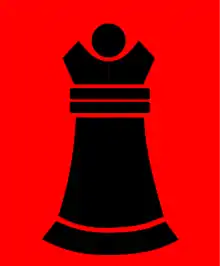206th Independent Infantry Brigade (United Kingdom)
206th Independent Infantry Brigade was a Home Defence formation of the British Army during World War II.
| 206th Independent Infantry Brigade | |
|---|---|
 | |
| Active | 12 October 1940-6 October 1943 |
| Country | |
| Branch | |
| Type | Infantry Brigade |
| Role | Home Defence |
Origin
The brigade was formed under the title of 206th Independent Infantry Brigade (Home) for service in the United Kingdom on 12 October 1940 by amalgamation of Headquarters Lothian Sub-Area and No 6 Infantry Training Group in Scottish Command. It originally comprised three newly raised infantry battalions[2] and one Territorial Army machine gun battalion that had seen service in the Battle of France.[2][3] It had no connection with 206th (2nd Essex) Brigade, a 2nd-Line Territorial Force formation raised during World War I.
Service
During its service the brigade came under the administrative control of several higher formations: Scottish Command (until 16 December 1940), 44th (Home Counties) Division (17 December 1940 – 23 February 1941), 56th (London) Division (23 February–14 November 1941), 46th Division (14 November 1941 – 2 July 1942, 20 August–30 November 1942), North Kent and Surrey Area (3 July–19 August 1942), 43rd (Wessex) Division (1 December 1942 – 19 May 1943), Hampshire and Dorset District (20 May–5 October 1943). The brigade remained in the UK throughout its service.[2]
The brigade was re-designated the 206th Independent Infantry Brigade in December 1941. Brigade headquarters was disbanded on 6 October 1943.[2]
Order of battle
The composition of the 206th Brigade was as follows:[2]
- 14th Battalion, Durham Light Infantry (12 October 1940 — 19 September 1942)
- 16th Battalion, Durham Light Infantry (12 October 1940 — 17 December 1940)
- 17th Battalion, Durham Light Infantry (12 October 1940 — 10 September 1942)
- 7th Battalion, Royal Northumberland Fusiliers (MG battalion) (12 October 1940 — 17 December 1940)
- 10th Battalion, South Staffordshire Regiment (4 December 1940 – 28 February 1942)
- 10th Battalion, Green Howards (1 February 1941 – 19 September 1942)
- 2/4th Battalion, South Lancashire Regiment (10 September 1942 – 25 May 1943)
- 9th Battalion, King's Regiment (Liverpool) (19 September 1942 – 12 April 1943)
- 9th Battalion, Buffs (Royal East Kent Regiment) (26 September 1942 – 1 October 1943)
- 2/4th Battalion, Essex Regiment (12 April – 1 October 1943)
- 11th Battalion, Devonshire Regiment (29 May – 8 September 1943)
- 12th Battalion, Cameronians (Scottish Rifles) (20 August – 23 September 1943)
Commanders
The commanders of 206th Bde were:[2]
- Brigadier F.G. Drew (until 24 May 1941)
- Brigadier R.A. Boxshall (24 May 1941 – 20 July 1942)
- Brigadier L. Tremellen (20 July 1942 – 10 May 1943)
- Brigadier G.F. Ellenberger (from 10 May 1943)
References
- Cole p. 131
- Joslen, p. 369.
- Joslen, p. 462.
- Sources
- Cole, Lt Col Howard, Formation Badges of World War 2, Britain, Commonwealth and Empire., London, Arms and Armour Press, SBN 853680787
- Joslen, H. F. (2003) [1990]. Orders of Battle: Second World War, 1939–1945. Uckfield: Naval and Military Press. ISBN 978-1-84342-474-1.
- Land Forces of Britain, the Empire and Commonwealth